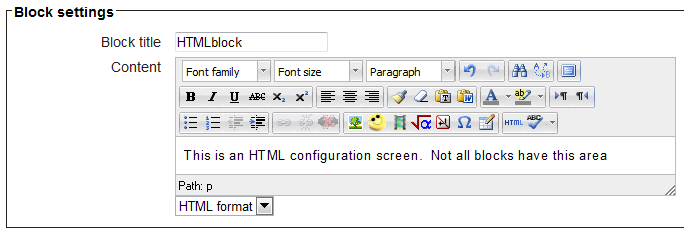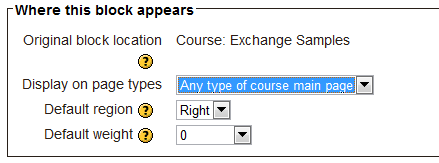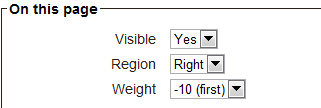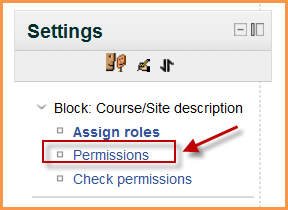Diferencia entre revisiones de «Configuraciones de bloque»
- Gestionando bloques
- Configuraciones de bloque
- Actividad reciente
- Actividades
- Actividades sociales
- Administración
- Anuncios recientes
- Aprendices
- Archivos privados
- Auto finalización
- Buscador de comunidad
- Búsqueda en foros
- Búsqueda global
- Calendario
- Canales RSS remotos
- Comentarios
- Cursos
- Cursos accedidos recientemente
- Cursos destacados
- Bloque de elementos recientemente accesados
- Enlaces de sección
- Entrada aleatoria del glosario
- Entradas de blog recientes
- Estado de finalización de curso
- Eventos próximos
- Flickr
- Gente
- HTML (Moodle 3.11 y anteriores)
- Ingreso
- Insignias recientes
- Línea de tiempo
- Marcadores para administradores
- Marcas
- Marcas del blog
- Mensajes
- Menú del blog
- Menú principal
- Navegación
- Planes de aprendizaje
- Resultados de examen
- Resumen de curso o sitio
- Retroalimentación
- Servidores de red
- Texto (Moodle 4.0)
- Últimas noticias
- Usuario ingresado
- Usuarios en línea
- Vista general de curso
- YouTube
- Bloques FAQ
m (tidy up) |
Sin resumen de edición |
||
| Línea 23: | Línea 23: | ||
===Donde aparece este bloque=== | ===Donde aparece este bloque=== | ||
En función de las | |||
Depending upon the context and users permissions, this area determines where this block will appear. | Depending upon the context and users permissions, this area determines where this block will appear. | ||
* | *Ubicación original del bloque: Proporciona información sobre dónde fue creado este bloque originalmente. | ||
* | *Mostrar en tipos de página: Permite a un usuario definir un contexto en el cual puede aparecer el bloque. El contexto donde se aplican estas opciones variará en función de los permisos que escoge las distintas opciones. Por ejemplo, si un administrador del sitio que aplique a un bloque la opción "Cualquier página" se verá en todo el conjunto del sitio mientras que si lo hace un docente se aplicará al curso, el contexto donde tiene permisos. | ||
* | *Región por defecto: Normalmente en la columna izquierda o derecha. | ||
* | *Peso por defecto: Donde quieres que aparezca en la columna respecto a otros bloques. -10 lo pondrá arriba, 10 lo pondrá abajo. 0 es neutral. | ||
[[File: Block configuration where appears.png]] | [[File: Block configuration where appears.png]] | ||
Revisión del 14:23 20 dic 2017
Nota: Pendiente de ACTUALIZAR esta traducción respecto a la página original en inglés (ver enlace hacia English en el cuadro abajo a la derecha). (otras páginas pendientes)
Moodle 2.x
Añadir un bloque a una página
Se pueden añadir bloques a una página al activar la edición y después usar el menú deplegable para 'Añadir un bloque' drop-down menu.
Por favor vea Bloques para ojear la lista de todos los bloques en una instalación estándar de Moodle. Su sitio puede tener complementos de bloques o su administrador del sitio pudo haber deshabilitado bloques específicos en su sitio.
Note: The ability to add a particular block to a page is controlled by an addinstance capability (e.g. block/comments:addinstance), which is allowed for the default role of teacher.
Configuración del bloque
After adding a block, click the edit icon in the block header to configure it.
Configuraciones del bloque
Certain blocks, such as the HTML block, allow a block title and more to be set.
Donde aparece este bloque
En función de las Depending upon the context and users permissions, this area determines where this block will appear.
- Ubicación original del bloque: Proporciona información sobre dónde fue creado este bloque originalmente.
- Mostrar en tipos de página: Permite a un usuario definir un contexto en el cual puede aparecer el bloque. El contexto donde se aplican estas opciones variará en función de los permisos que escoge las distintas opciones. Por ejemplo, si un administrador del sitio que aplique a un bloque la opción "Cualquier página" se verá en todo el conjunto del sitio mientras que si lo hace un docente se aplicará al curso, el contexto donde tiene permisos.
- Región por defecto: Normalmente en la columna izquierda o derecha.
- Peso por defecto: Donde quieres que aparezca en la columna respecto a otros bloques. -10 lo pondrá arriba, 10 lo pondrá abajo. 0 es neutral.
See Perfiles de usuario for instructions on how to make a block appear on all user profile pages.
En est apágina
- Visible - Yes or No.
- Region - Here you can override the column preference on this page.
- Weight - Here you can override the default setting on this page.
'Bloques pegajosos (Sticky blocks)'
The term 'sticky' block was used in older versions of Moodle to mean blocks which the admin added either site-wide or to the Mi hogar page and which could not be deleted by regular users. Although the term is no longer used, it is still possible to make blocks 'sticky' and in a wider variety of locations.
In Moodle 2.4.2 onwards, if an admin deletes a "sticky" block in a course, they receive a warning of the site-wide consequences of this action before it is deleted.
Here are a few examples:
Haciendo a un bloque pegajoso para todo el sitio
The Moodle administrator might wish for example to display support contact details sitewide using an Bloque HTML called 'Helpdesk':
- As an administrator, turn on the editing on the front page and add the block you wish to make sticky.
- For Where this block appears>Page contexts, choose 'Display throughout the entire site'.
- Decide other settings according to your preference and save.
- The block will now appear on all pages of your Moodle.
Haciendo a un bloque pegajoso para todo un curso
The teacher might wish for example to display the Bloque de mensajes everywhere in the course. This would allow students easily to message each other and their tutors not only on the course from the main page but also on individual activities. The block would be available on admin pages too.
- As a teacher in the course, turn on the editing on the course main page and add the block you wish to make sticky.
- For Display on page types, choose 'Any page'
- Decide other settings according to your preferences and save.
- The block will now appear on all pages of the course.
Haciendo a un bloque pegajoso en una categoría
A user with category rights might for instance wish to display a Bloque de canales RSS remotos in all of the courses within a particular category, such as a Head of Science adding Science news feeds to the Physics, Biology and Chemistry courses. While this should be possible, there are currently problems with blocks on category pages not saving the required page context. See MDL-31616
Making a block sticky in a resource or an activity
A teacher might wish to display a block in one particular resource or activity, for example a Head of Faculty might make create a Book for departmental policies and wish to add the comments block to every chapter/page of a book so colleagues can give quick feedback. (Note that such a comments block would be the same block on each chapter/page)
- As a teacher in the course, turn on the editing and click into the resource/activity -in this case a Book and add the block.
- For Display on page types, you will see (for example) 'mod-book*'
- Decide other settings according to your preferences and save.
- The block will now appear on all related screens.
Añadiendo un bloque a todas las páginas de perfil de usuario
Añadiendo un bloque a la página de Mi hogar para todos los usuarios
See Mi hogar Note that such a block would not be truly 'sticky', in that users can customise their My home page and could, if wished, delete the block.
Permisos del bloque
Role permissions for a block can be changed by clicking the Assign roles icon (a face and mask) in the header of the block then via Settings > Block administration > Permissions.
Vea Bloques FAQ for details of how to hide front page blocks from non-logged-in users.







